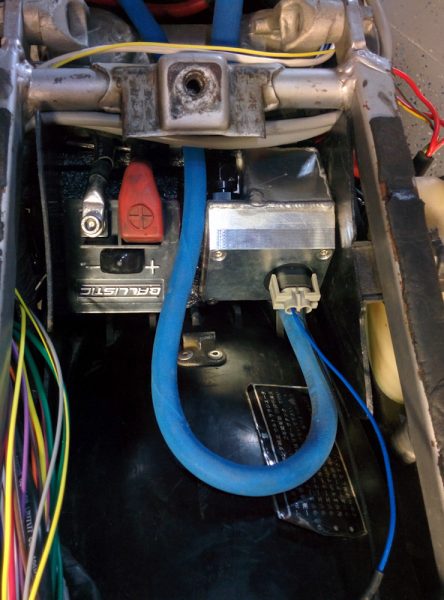As I started working on hooking up the fuel pump, I also realized it was time to make new battery wires. Because the Ballistic lithium battery is much smaller than the original lead acid one, the existing positive wire was too short, and the ground wire is fraying, so I decided to redo that one, too.
I’d already ordered AWG #6 (about 13mm^2 for the Europeans) battery wire and lugs a while ago, knowing that I was going to have to do this, but until everything was in place it didn’t make sense to make the wires. Now it was time.

Here’s the new battery compartment, with the Lithium battery on the left and the fuel pump housing on the right.
Using a pretty cheap hydraulic crimper I’d gotten off ebay, it was a breeze to crimp the lugs onto the wire. However, I was unable to find lugs that had the same shape as the old ones, so the rubber covers on the positive wire did not fit super well. They are covered, though, so I think it’s good enough. I also realized that I was lucky, because the seat has a large tongue that hooks in under the bracket the tank sits on in the top center of the picture above. This tongue is actually low enough that it touches the rubber boot on the positive terminal. It doesn’t actually touch the terminal, though.
I was also going to run the fuel lines, but I realized that the 180-degree turn in the fuel line needed to pass forward between the battery and the fuel pump housing requires bending the hoses considerably more sharply than the required bending radius, which is 3″. Instead, I’ll get a 180-degree hose end and use that to turn it around. That should pretty much have the right offset to come out in between the battery and pump housing.
I also need to make some sort of bracket to hold the fuel filter, which will sit immediately above the frame rail in the picture above, above the #1 spark plug. There’s a space there, under the tank and to the left of the cam chain cover, where the fuel filter can go. It just needs to be held by something so it doesn’t vibrate against the tank or head cover.
Patrik,
Just bought a ’99 VFR800 (best of the breed?). Always wanted to get the V-4 experience.
The bike seems to be in pretty good shape. Only one owner and 19,000 miles, always garaged. Clean, starts easy, runs great. The only minor issue is that the prior owner was a deferred maintenance kind of guy, not a wrench-turner at all: it’s got the original fork oil, original spark plugs, valve clearances have never been checked/adjusted, starter valves have never been synchronized, idle is set at 1,000 rpm (and there’s probably more). I’ll actually enjoy doing the cleanup and maintenance this winter/spring.
Greg
Nice! Welcome to the club. (Although the VFR800 might be too comfortable to be in the same club as the NC30… 😉
No valve clearance adjustment in 19,000 miles… I hope the valves are OK.
Are you going to Megasquirt that one, too? It might be a bit easier than your earlier project.
Thanks, I’ve wanted one for quite a while.
I’m trying to approach this VFR differently (from my other two FI project bikes). No big changes, just bring the bike up to a high standard of maintenance with just a few little VFR-community-accepted upgrade/update items. I don’t want to do anything that would put a future buyer off because I’m only planning to keep it for a while, enjoy it, and then eventually sell it on (unless I end up finding that I can’t part with it).
Surprisingly, the maintenance schedule shows the first instance of valve inspection (with adjustment if necessary) at 16,000 miles. So this bike is only 3,000 miles beyond that specification. All the VFR guys say these engines were built to extremely high standards and it’s not uncommon for the valves to go well past 16,000 mile interval without needing adjustments (I guess the aluminum alloy that the heads are cast from must be very stable and/or dense, providing very resilient valve seat faces).
Love the sound. Of course the VFR800 is a 180 degree crank engine rather than a 360. I think they both sound great but Honda is calling the shots on what’s readily available. The soundtrack of 1/2 of a flat-plane V-8 engine is music to my ears.
Always looking forward to the next update from your project.
Speaking of music, this is the best recording I’ve found: https://youtu.be/uTxe1_MPdiw. I believe that is an RC30.
Very nice. Here’s the best video I’ve found of the 180 degree crankshaft version. https://www.youtube.com/watch?v=dcZcY2oJ-nM
(it’s a rare occurrence on youtube when somebody posts up a video with truly good sound, in most vids the engine sound is masked by that signature GoPro cheap-plastic-box rattle combined with overdriven microphone waveform clipping and/or horrible wind noise)